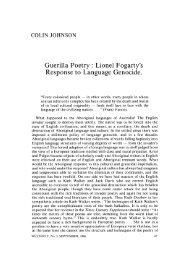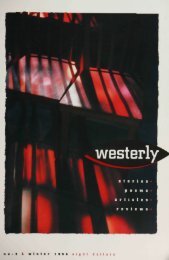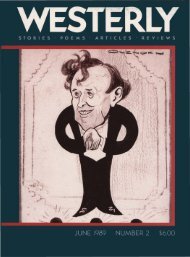But the two Town Planners did not justifythe removal on aesthetic or symbolic groundsalone. They introduced a utilitarian factor,traffic control, and they made it clear that theBarracks had to make way for the motor car—"The eventual removal of the Barracksand the temporary State Government buildingsadjacent to them .... would offer anadequate traffic solution and would providea clear vista to Parliament House along thelength of St. George's Terrace. The most importantstreet in the city demands an importantterminal treatment"."For vital traffic needs and for the generalimportance of the city the old Barracks, aninadequate and obsolete building, . . . .should be displaced."^The Stephenson-Hepburn Report became thebasic document for the planning and developmentof Perth and successive governmentsagreed to adhere to the broad implementationof its proposals. Although the Old Barracksformed an almost insignificant part of the Report,its subsequent role in local politics is anillustration of the problem of town planningin an aspiring democracy.From time to time, town planning calls forthe suppression of politics, and it is often difficultto reconcile this characteristic with democraticideals. Many of the material changesplanned for a city touch sensitive nerves in thebody politic. Every community has its sacredcows—and Australian cities are no exception.When planners recommend changes, whetherby construction, by demolition or by reclamation,there are likely to be strident, and sometimesemotional cries from dissident individualsor groups; and these can be difficult forparty politicians to handle. Until recently, politicianshave found the professional prestige oftown planners a comfortable shelter from thepublic's outcry, and much has been achievedin the name of the expert. But professionalprestige can wear thin—particularly if toomany sacred cows are threatened with deathover too short a period of time—and hacklesmay easily be roused.As a result of the predominantly urban distributionof Australia's population, the politicsof its city planning has some distinguishingcharacteristics. Many of the issues are comprehensibleto a major part of the electorate andmost of each State's electorate has a first handacquaintance with the locale and the buildingsinvolved. Seemingly minor issues can becomepolitical dynamite. The Old Barracks was inthis category. For Perthites, it was within sight;it was familiar bricks and mortar; and the alternativeto its preservation was widely understood.It was evident in Perth in 1966 that theissue of Barracks' demolition attracted morepublic attention than the Ord River Project,Vietnam, British troops east of Suez, PresidentJohnson's visit to Australia, or even militaryconscription. After earlier irritations about reclamationof parts of the Swan River, theBarracks issue indicated that the people ofPerth had become hyper-sensitive to the shortrunconsequences of town planning; in otherwords, that the town planners' honeymoon wasover.The following explanation of the Old Barracksissue, and the moral it contains, willproceed by way ofOpposing the Town PlannerThe Bulldozers move inMeasuring Public OpinionThe Parliamentary DebateThe moral of the storyOpposing the Town Planner:In the light of criticism of the Barracks inthe Stephenson-Hepburn Report, and the widespreadacclaim the Report enjoyed, the effectiveorganisation of opposition to the proposalfor demolition took several years. The supportthe Report received from the newspaper TheWest Australian might have spurred the effortsof those seeking to preserve the building; buton the other hand it might also have increasedtheir despair at the apparent hopelessness oftheir task. For example. The West Australian(8th August 1959) claimed—"it is unUkely that a convincing case could bemade for keeping the Barracks. It has a slenderhistorical background and is of dubiousarchitectural merit or interest. Its removalwould enable the hill rising to Parliamenthouse to be fashioned into an impressiveclimax of St. George's Terrace . . . ."^One of the first moves towards creating oppositionwas the establishment in 1959 of theNational Trust, which in 1964 was placed ona statutory basis.'^ In its early years the Trustundertook a classification of Historical Buildingsin Western Australia in which the OldBarracks was rated Class 'A'—"to be preservedat all cost". This was an indication of thingsto come.In March 1961 a deputation from the NationalTrust and the W.A. Historical Society(introduced by Mr H. Guthrie, M.L.A.) presentedthe Premier (Mr Brand) with a petitionsigned by 700 people supporting retention ofthe Barracks and asking the government tocancel its plan to demolish it.^ And Marchalso saw a debate on T.V. between Professor54 WESTERLY, No. 1 of 1967
Gordon Stephenson, Mrs Ray Oldham of theHistorical Society, and Mr Hew Roberts of theNational Trust, but again The West Australianfound little satisfaction in the case for preservation—"Professor Gordon Stephenson was clearlythe winner .... there is no convincingreason why the Barracks should stay. Theyhave little architectural merit and their onlyhistorical significance is that they were builtto house pensioners who guarded convicts."^In October 1961, came the establishment ofthe Barracks Defence Council. This body drewits representatives from eight community institutionsand could claim widespread communitysupport. Representatives came from—The National TrustThe Royal W.A. Historical SocietyThe Women's Service GuildThe National Council of WomenThe Victoria LeagueThe Tree SocietyThe Fellowship of Australian WritersThe Citizens Committee for the Preservationof King's Parkand, upon its creation, Council members immediatelybegan distributing leaflets in defenceof the Barracks.Action was one thing, but public esteem wasanother, and in November 1961 the BarracksDefence Council at its second meeting soughtto establish the latter. It appointed the Rt.Reverend C. L. Riley (one time Bishop ofBendigo) to be its president, and from thatpoint it became an impressive fighting forcewith its prestigious leader and a politicallysignificant following.If 1961 was the formative year for the organisationof the defence of the Barracks, then1962 was the year for giving the case legitimacy.John Betjeman visited Perth in December1961, and being a specialist on Victorian architecturehis views on the Barracks were eagerlysought. The Barracks Defence Council was notdisappointed. "The buildings were [built] by agreat and courageous people" said Betjeman inrecognition of the convict labour that helpedtheir construction. They "had the texture oftime and had to be saved". "Otherwise", hepredicted, "they would make way for moreservice stations".^"Moreover, Betjeman persuaded Lord Euston(Chairman of the Society for the Protection ofAncient Buildings, London) not to miss seeing"Perth's beautiful Gothic revival brickwork"on his Australian visit early in 1962. ButHuston's comments were guarded. He wroteto The West Australian:"Speaking from the view point of a visitorwith no previous knowledge of this city, Ishould like to express the hope that at leastthe towers and archway of the Old Barrackswill be preserved.""They seemed to me to create a most valuablefocal point at the end of St. George's Terrace,the removal of which would surely beregretted in years to come"."Then in May 1962, Perth received the visitof Dr Raynor Banham (Architectural Historian,Critic, and Joint Editor of Britain'sArchitectural Review), and Barracks defenderswere pleased to have him reported (18.5.62)as claiming that:"The old Barracks reduced the otherwise unlimitedview and [they] keep the street spacetidy".i2Fortified with this support from overseascelebrities, the Barracks Defence Council in1963 turned to the technique of public petitionin order to impress the political masters. Some3,000 people signed-up as advocates for theretention of the building and, in July, theircollective opinion was presented to the government.But the impact was minimal. It seemedthat the final decision had been taken, andthe weight of 3,000 signatures was not enoughto affect the balance. At this point the Barracksissue lost its momentum in public discussion.On the whole the years 1963-65 were yearsof relative calm on the part of the defenders.For the Barracks Defence Council it was aperiod for the resolution of its own inner conflictsabout tactics. There were proposals thatthe front of the Barracks (including the mainarchway) could be kept as a historicalmuseum; and there was an increasing recognitionof the difficulties of preserving thewhole building in the face of the extensivescale of the road works to be undertaken inthe area.In March 1963, after a conference with theBarracks Defence Council, Premier Brand announcedthat the Council's claims, "for theretention of the wings had been rejected asimpracticable"; and he asserted that, "the onlypart which could possibly be retained is thearchway". It was also reported that the BarracksDefence Council had "accepted thisfact".i3 Then, on 9th April the Premier announcedthe Government's plan:"we felt the fairest way to decide would beto let it stand after the wings are gone sothat the Government and public can forma final opinion".'*WESTERLY, No. 1 of 1967 55
- Page 1 and 2:
arc de triomphe
- Page 3 and 4:
westerlya quarterly reviewEDITORIAL
- Page 5: westerlyNo. 1 of 1967CONTENTSSTORIE
- Page 8 and 9: "Oh, old Jack's morals are alright
- Page 10 and 11: were looking down on a face so scru
- Page 12 and 13: in the comfort of cars. Ellie and T
- Page 14 and 15: grand, final fling. His bright eyes
- Page 16 and 17: The rotting wood in the window fram
- Page 18 and 19: John lumbered up the steps of the G
- Page 20 and 21: night storm that flashed and twinkl
- Page 22 and 23: Quietly the young man left to fetch
- Page 24 and 25: "Bother, I've forgotten your aktavi
- Page 26 and 27: patiently as she hesitated. What wa
- Page 28 and 29: THEUNIVERSITYBOOKSHOPAT THE UNIVERS
- Page 30 and 31: PREFACE(Emaux et Camees)Pendant les
- Page 32 and 33: NOELLe ciel est noir, la terre est
- Page 34 and 35: LA DERNIERE FEUILLEDans la foret ch
- Page 36 and 37: LES COLOMBESSur le coteau, 1^-bas o
- Page 38 and 39: LA MONTREDeux fois je regarde ma mo
- Page 40 and 41: FUMEELa-bas, sous les arbres s'abri
- Page 42 and 43: PENDANT LA TEMPETELa barque est pet
- Page 44 and 45: PAYSAGEPas une feuille qui bouge,Pa
- Page 46 and 47: LE MERLEUn oiseau siffle dans les b
- Page 48 and 49: LETRILLAEnfant, pourquoi tant de pa
- Page 50 and 51: L'ARTOui, I'oeuvre sort plus belleD
- Page 52 and 53: ARTYes, lovelier do works of artEme
- Page 54 and 55: Some JOURNALS published byUNIVERSIT
- Page 58 and 59: The years 1963-65, therefore, were
- Page 60 and 61: COCD00(Moasu;-(a!CocP4Q
- Page 62 and 63: •OS. ^ " ^-«w" 1 a 1-1* r^^ril1
- Page 64 and 65: —representing one home in about 5
- Page 66 and 67: ingly in the determination of its p
- Page 68 and 69: For a personal view. Westerly asked
- Page 70 and 71: Abrolhos Islands, is believed to ha
- Page 72 and 73: added dimension of individual human
- Page 74 and 75: and feelings of his people or of th
- Page 76 and 77: theological developments of the las
- Page 79 and 80: IF YOU DON T KNOW HOWDON'T DO IT•







